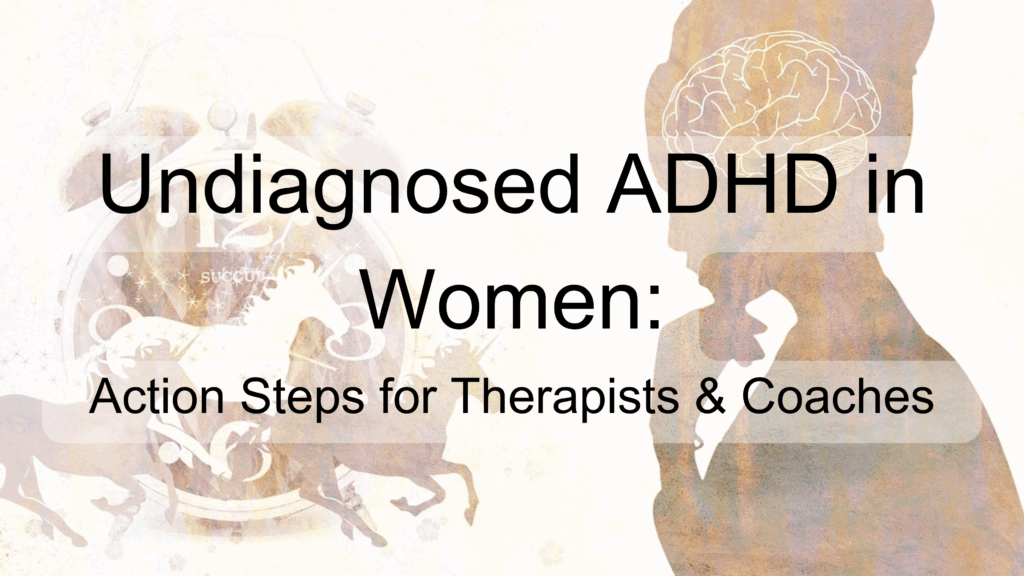Undiagnosed ADHD in Women: Action Steps for Therapists & Coaches
“Women have been looking for themselves in a diagnostic mirror designed for boys.”
— Dr Tony Lloyd, Europe’s No. 1 ADHD Doctor
For too many of us, that mirror still lies. It reflects diligence (“she’s so quiet”), perfectionism (“she’s just a bit anxious”), or burnout (“she tries to do everything”). What it hides is the very real possibility that the restless mind, racing heart rate before deadlines, and volcanic emotions are not moral failings at all—they’re undiagnosed ADHD.
Why This Conversation Can’t Wait
- Adult diagnosis is the norm, not the exception. New CDC data show that 61 % of women receive their ADHD diagnosis after childhood, compared with 40 % of men. Only one‑quarter of girls are picked up before age 11 .
- The curve just doubled. An analysis of electronic health records by Epic Research revealed that the percentage of women aged 23 to 49 newly diagnosed with ADHD nearly doubled from 2020 to 2022—the steepest rise of any demographic group.
- Masking corrodes mental health. Women routinely camouflage symptoms to meet social expectations, a pattern linked to anxiety, depression, and post-diagnosis burnout .
- Hormones can create a rollercoaster effect. A decline in oestrogen, premenstrally, postpartum, and during perimenopause, can spike inattentiveness and emotional dysregulation.
In a recent article, Psychotherapist Sari Solden names the cost: “They don’t know how hard they are working just to survive… living is not supposed to be that hard.”
From Invisible to Inevitable: Spotting the Signs
The “Hidden Curriculum” of Female ADHD
| Surface Label | Possible ADHD Reality |
| “Dreamy, shy, day‑dreamer” | Inattentive‑type ADHD with rich internal world |
| “Over‑achiever / perfectionist” | Hyperfocus + dread of letting balls drop |
| “Too sensitive” | Rejection‑Sensitive Dysphoria (RSD) |
| “Moody around period” | Oestrogen‑linked executive‑function crash |
Self-check tools: The Adult ADHD Self‑Report Scale (ASRS‑v1.1) and the female-tuned QSQ‑F can signal whether a formal assessment is warranted. Keep a two-week symptom diary that notes sleep, cycle day, and stressors—clinicians love data.
Preparing for Diagnosis: Your Advocacy Script
- Curate evidence. Please bring that diary and any school reports mentioning concentration, lateness, or “talks too much.”
- Frame the impact. Clinicians diagnose impairment. Describe concrete falls (missed deadlines, relationship blow-ups).
- Name the comorbidities. Anxiety, binge‑eating, and PMDD highlight how they wax and wane with ADHD patterns.
- Inquire about female-specific criteria. “How do you account for masking, cycle-related swings, and RSD in your assessment?”
Consider reputable private assessments if wait‑lists are long, but verify professional registration and post-diagnosis support options.
Action Steps for Thriving (Diagnosis or Not)
Daily Habits That Respect a Divergent Brain
| Tactic | Why it Works | Quick Start |
| 3‑Hour Work‑Window Method 12 WEEK COACHING PROGRAM | Matches natural dopamine sprints; avoids afternoon crash | Schedule two focused blocks (90 min + 30 min break + 60 min). |
| Energy‑Based Time‑Blocking 12 WEEK COACHING PROGRAM | Plans tasks when oestrogen & alertness are higher (follicular AM) | Colour‑code high‑brain vs. low‑brain tasks in calendar. |
| Body‑Doubling/Co‑Working | Externalises accountability | Join an online pomodoro room or invite a friend during chores. |
| EFT Tapping for RSD 12 WEEK COACHING PROGRAM | Calms limbic reactivity in <3 minutes | Tap before opening feedback email. |
Relationship & Workplace Advocacy
- The 30-minute “Relationship Temperature” Talk: A weekly check-in prevents resentment from building‑up . This is a 12-WEEK COACHING PROGRAM.
- The DESC script for conflict (Describe–Express–Specify—Consequence) keeps discussions concrete . This is a 12-WEEK COACHING PROGRAM.
- Request accommodations, such as noise-cancelling headphones, flexible deadlines, and written instructions. Link requests to performance benefits for the employer, not personal “favours.
Hormone‑Savvy Adjustments
- Track symptoms against your cycle for three months.
- Discuss with prescriber whether a slight stimulant‑dose increase in the late luteal phase could help (emerging evidence supports cycle-based titration ).
- Nutrient triad—omega‑3, magnesium, iron—supports dopamine and mitigates PMS‑ADHD overlap.
Strengths First: Re‑authoring the ADHD Narrative
Pop‑culture icon Paris Hilton reframed her own diagnosis: “ADHD isn’t a limitation; it’s my superpower… the most magical things happen when you break free from expectations.”
List your “ADHD edges” (creativity, crisis‑navigation, hyper‑empathy) and design roles or hobbies where they shine. Does a business need innovation? A community group needs high-energy problem-solving. That’s your lane.
Joining the Movement
- Share the CDC and Epic stats with friends, HR, and GPs—bias thrives in silence.
- Mentor another woman starting her diagnostic journey.
- Advocate for guideline updates that include female presentations and hormone considerations.
- Invest in specialised coaching. Programs like the 12‑Week “Thriving in Business & Love” ADHD Work‑Life Harmony Method pair executive‑function skill‑building with relationship tools—because our careers and connections rise or fall together . 12 WEEK COACHING PROGRAM.
Closing Words
Diagnosis is not a verdict; it’s an invitation to design environments, craft boundaries, and live at full voltage. As Solden reminds us, life “is not supposed to be that hard.” The more we unmask, the more mirrors we replace with windows that let the light in—for ourselves, our daughters, and every woman still wondering why she’s exhausted from trying to be “normal.”
You deserve better than invisible survival. You deserve visible, vibrant, thriving. Start today.
Wondering what to read next; Emotional Infidelity: The Hidden Hurt That Can Erode Even Loving Relationships
Visit my store to find insightful e-books on a range of topics:
Would you like to work with me, find out more about my programmes here

